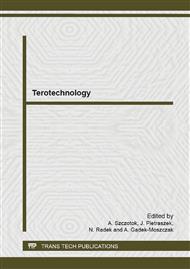p.3
p.9
p.17
p.23
p.29
p.35
p.43
p.51
Tribological Properties of Diamond-Like Carbon Coatings
Abstract:
The aim of the study was to analyze the superhard anti-wear diamond-like carbon coatings produced by Plasma Assisted Chemical Vapor Deposition (PACVD) and Physical Vapour Deposition (PVD). The a-C:H and a-C:H:W coatings were deposited on steel elements operating under friction conditions. The analysis involved comparing the tribological properties of coated metal elements with those of uncoated elements. It was essential to analyze how the coating composition and structure influence the tribological behaviour of elements under dry and lubrication friction conditions. The coating structure was analyzed by observing the topography of the surface and the cross-sections using an atomic force microscope (AFM) and a scanning electron microscope (SEM). The results were employed to determine the elemental composition and thickness of the coatings. The tribological tests were performed applying a ball-on-disc tribometer and using a pin-on-plate tribometer. The tribological properties were analyzed also in a micro scale using a microtribometer. Compared with the substrate material - steel, the diamond-like carbon coatings showed lower linear wear, lower friction coefficient and higher hardness.
Info:
Periodical:
Pages:
9-15
Citation:
Online since:
January 2014
Authors:
Keywords:
Price:
Сopyright:
© 2014 Trans Tech Publications Ltd. All Rights Reserved
Share:
Citation:


